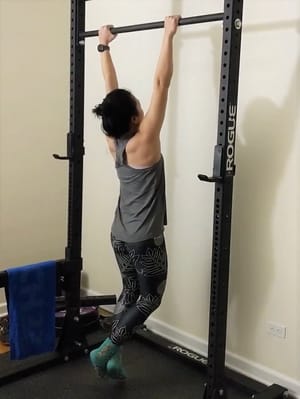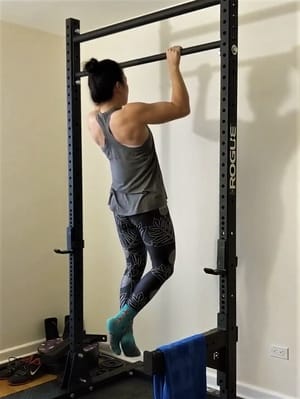This post contains affiliate links.

The first pull-up is so hard to get! I spent 2-3 years struggling before I unlocked five strict pull-ups after trying band-assisted pull-ups. Eventually, I worked up to 15.
So how do you get your first strict pull-up? A strict pull-up requires technique and strength to recruit muscles across the body to act in harmony to pull your body towards the bar. It takes time, effort, and consistency to figure out the technique and build the strength to get a strict pull-up.
Keep reading for instructions to learn my technique and progressions to start building strength so you can be on your way to achieving a strict pull-up.
Table of Contents
What Exactly Is A Strict Pull-Up?
A strict pull-up starts from a dead hang; it means you’re hanging vertically from the bar, arms fully extended, and feet off the ground. Then you pull your body towards the bar until your chin touches the bar.
DON’T jump into the pull-up to get to the top.
DON’T use momentum by kipping or swinging into the pull-up.
DON’T bicep curl your body into the bar.
How To Do A Strict Pull-Up
Let me break it down for you.
Step 1: Grab the pull-up bar.
Make sure hands are pronated or overhand (palms away from the body) and grip shoulder-width or a bit wider apart for a standard pull-up

Step 2: Dead hang.
Hang vertically from the bar, fully extend the arms, and remove the feet off the ground.

Step 3: Set up by engaging these muscles before and during the pull.
- Scapular retraction At this point, your shoulders will be next to your ears. Pull your shoulders down by thinking about creating distance between your shoulders and ears. You should feel your scapula lock down and back.
- Shoulders externally rotated. The cues from the scapular retraction will safely rotate the shoulders externally. Naturally, the torso will angle away from the bar ever so slightly from the shoulders externally rotating.
- Fully engage the lats. The previous steps should help you engage the lats.

Step 4: Pull yourself to the bar until your chin touches the bar.
- Bring your chest to the bar. Stabilize the chest.
- Keep your elbows under the bar. They will end up next to your body at the top of the pull-up.
- Keep shoulders externally rotated. Don’t roll them forward and hunch into the bar.
- Engage the lats. Feel the connection as if you were doing a lat pull-down.
- Biceps and forearms are only assisting. Don’t bicep curl your body up.

Step 5: Return to a dead hang.
Slowly reverse the movements.

Pull-Up Tutorial Video
In this video, I demonstrate and explain each step mentioned above.
Pull-Up Progressions
If you’re working towards your first pull-up, progressions will help to build the strength and technique to perform your first pull-up. Each of these progression exercises will help to get your first strict pull-up.
Start with #1 and work towards #5 on this list for 3 to 5 sets of 8 reps. Proceed to the next step when you can complete the progression exercise with control. Feel free to jump around steps to work on your weaknesses. Continue working on #1 with adjusted levels of support to practice putting it all together.
#1. Band-Assisted Pull-Ups
The resistance band is an effective and inexpensive piece of equipment to help build pull-up strength. The band-assisted pull-up best mimics the range of motion for a strict pull-up. Power resistance bands come in different thicknesses to adjust the level of support.
- Choke the band around the bar and pull the longer part through so the knot is secure. At this point, the band should be secured to the pull-up bar on one end and dangling from the bar on the other end.
- Grab the pull-up bar with both hands and place either both knees or feet on the band.
- Set up exactly as you would for a strict pull-up. Follow the steps mentioned above for “How To Do A Strict Pull-Up.”
#2. Straight-Arm Lat Pull With Bands
The lats are major pulling muscles in the pull-up. Practice engaging the lats with this exercise.
- Set up and position your body with a power resistance band like the “Band-Assisted Pull-Ups” above.
- Keep your arms straight and press down on the bar until your shoulders shift backward. You should feel your lats activate.
#3. Hanging Scapular Pull
Scapular retractions will teach you how to initiate the pull at the bottom.
- Grab the pull-up bar with both hands and dead hang.
- Practice pulling your shoulders down by thinking about creating distance between your shoulders and ears. You should feel your scapula lock down and back.
#4. Static Holds
This exercise will build strength in the top position.
- Hold your chin over the pull-up bar for a set amount of time.
- Leverage your lats to keep you up.
- To increase difficulty, maintain a hollow body throughout the exercise.
#5. Eccentric Pull-Ups (Pull-Up Negatives)
This exercise should utilize all the muscles engaged in a strict pull-up.
- Begin with your chin over the pull-up bar.
- Lower your body to the bottom as slow as possible. Try to reverse the movements of “How To Do A Strict Pull-Up.” As strength builds, the movement will become slower and more controlled.
Pull-Up Progressions Video
In this video, I demonstrate and explain each pull-up progression mentioned above.
Which Pull-Up Bar Should You Buy?
Best Doorway Pull-Up Bar
Grab yourself a PROSOURCEFIT DOORWAY CHIN-UP/PULL-UP BAR for one of the best upper body strength exercises. This bar provides various handles for wide, hammer, and close-grip exercises. With the bar on the doorway, you can perform pull-ups to train lats, scapular retractors, biceps, forearms, and even core when performed correctly. Place the bar on the floor and perform dips to strengthen the triceps.

Get your bar on Amazon here: https://www.amazon.com/dp/B002YQUP7Q?tag=homestrengt0c-20
Best Pull-Up And Dip Station
If you need a sturdier pull-up bar and have an empty corner at home for a pull-up and dip station, the SPORTSROYAL PULL UP AND DIP STATION is perfect for you. This station can support pull-ups, dips, knee raises, and push-ups. The height of the pull-up bar and backrest are adjustable and designed with comfort in mind.

Get your bar on Amazon here: https://www.amazon.com/dp/B07SM8VJ6P?tag=homestrengt0c-20
Best Squat Racks
If you plan to build a home gym for barbell training, check out the Buying Guide For Squat Rack for squat racks that come with the pull-up bar!
Best Free Pull-Up Bar
If you don’t have space or money for a pull-up bar, your local park playground is an excellent free option.
Related Questions
Why should you learn strict pull-ups? Achieving strict pull-ups is a huge accomplishment because it builds foundational strength and body awareness that is key to any level of fitness or sport. And unlike kipping pull-ups, it develops muscles through the full range of motion.
Should you work on other exercises to get a pull-up? Sure, work on building strength in pulling and core muscles, but it doesn’t guarantee that you’ll get a pull-up. You can be a relatively strong person without the awareness to be able to do a pull-up. That’s why the pull-up progression exercises mentioned earlier will have a direct transfer to pull-up progress.
Do you want to get more pull-ups? Consistency is key. Continue incorporating bodyweight pull-ups with some progression exercises until you can get 8-10 strict pull-ups with ease. Then you can start adding weight to your pull-ups.
HomeStrengthToolbox.com is a participant in the Amazon Services LLC Associates Program, an affiliate advertising program designed to provide a means for sites to earn advertising fees by advertising and linking to Amazon.com. We also participate in other affiliate programs which compensate us for referring traffic at no extra cost to you.
